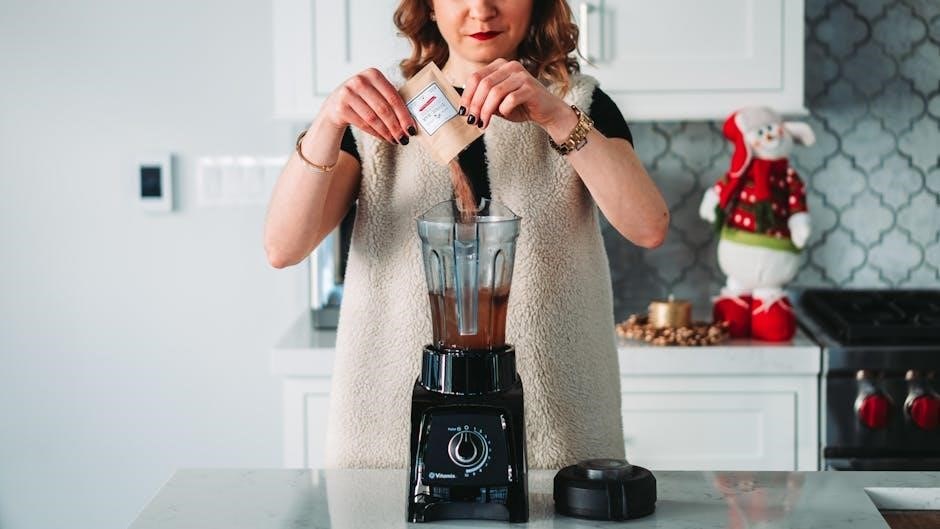2 4 d herbicide mixing instructions
Understand the Product Formulation
2,4-D herbicide is a post-emergent selective herbicide available in various formulations, including liquid concentrates, dust, and granules. Each product may have different active ingredient concentrations, such as 4% or 40% solutions. The formulation affects mixing ratios and application methods. Always read the label to identify the specific product type and active ingredient concentration. Liquid concentrates are common for lawn applications, while granules may be used for broader coverage. Understanding the formulation ensures proper mixing and effective weed control, avoiding potential over-application or under-dosing. This step is critical for safe and efficient use.

Check the Product Label
Before mixing or applying 2,4-D herbicide, it is essential to thoroughly read and understand the product label. The label provides critical information tailored to the specific formulation, ensuring safe and effective use. 2,4-D products vary in concentration and chemical form, so the label will specify the active ingredient percentage, recommended mixing ratios, and application rates. For example, a 4% solution may require different handling compared to a 40% concentration. Always verify the product name and formulation type to avoid confusion.
The label will outline the correct mixing ratio, typically expressed in ounces of herbicide per gallon of water or per acre. For smaller-scale applications, such as spot treatments, the ratio might be 1 to 2 fluid ounces of 2,4-D per gallon of water. For larger areas, the ratio may increase, depending on the target weed species and growth stage. Some labels also provide guidelines for adjusting the concentration based on weed size or type, ensuring optimal results without over-application.
In addition to mixing instructions, the label will include safety precautions, such as required personal protective equipment (PPE) and application restrictions. Many 2,4-D products specify that users should wear long sleeves, gloves, and eye protection to minimize exposure. The label may also warn against application during certain weather conditions, such as high winds or extreme temperatures, to prevent drift or evaporation. Environmental precautions, like avoiding spray near water sources or wildlife habitats, are also typically highlighted;
Pay special attention to any warnings about tank mixing with other herbicides or additives. Some products may specify compatibility with certain chemicals, while others may advise against mixing to prevent incompatibility issues. For example, mixing 2,4-D with glyphosate or other herbicides may require specific ratios to maintain efficacy and avoid equipment damage. Always follow the label’s instructions for tank mixing to ensure safety and effectiveness.
Finally, the label will provide application timing guidelines, such as the optimal stages of weed growth for treatment and any reapplication intervals. It may also include information on waiting periods before reseeding or allowing pets and children to enter treated areas. By carefully following the label’s instructions, you can achieve effective weed control while minimizing risks to people, pets, and the environment. Remember, the label is your guide to using 2,4-D herbicide responsibly and efficiently.

Determine Mixing Ratios
Determining the correct mixing ratio for 2,4-D herbicide is crucial for effective weed control and safety. The mixing ratio varies depending on the product formulation, weed type, and application method. For most liquid concentrate products, the recommended mixing ratio is between 1 to 4 ounces of 2,4-D per gallon of water. For example, a common ratio for broadleaf weed control is 2.5 ounces of 2,4-D concentrate per gallon of water, which is sufficient to treat approximately 400 square feet of area. However, for larger areas or more stubborn weeds, the ratio may be increased to 5 ounces per gallon.
When using a backpack or tank sprayer, the mixing ratio can be scaled up proportionally. For instance, a 60-gallon sprayer may require 15 to 20 ounces of 2,4-D concentrate to cover 8,000 to 10,000 square feet. Spot treatments often use a lower concentration, such as 1 to 2 ounces per gallon, to avoid over-application and potential harm to desirable plants. Always double-check the product label for specific recommendations, as ratios can vary between brands and formulations.
The mixing ratio also depends on the growth stage and size of the target weeds. Smaller weeds or younger growth may require a lower concentration, while larger, more established weeds may need a higher concentration to ensure effective control. For example, a ratio of 3 ounces per gallon is often recommended for medium-sized weeds, while 4 ounces per gallon may be necessary for tough, mature weeds. Adjusting the ratio correctly ensures that the herbicide is applied at the optimal level for the specific weed species.
Environmental factors, such as soil type, temperature, and humidity, can also influence the mixing ratio. High temperatures may require a slightly lower concentration to prevent volatilization, while cool, damp conditions may allow for a higher concentration. Always consider these factors to maximize efficacy and minimize waste. Additionally, if tank-mixing 2,4-D with other herbicides or additives, follow the label’s compatibility guidelines to avoid adverse reactions.
Finally, calculate the total amount of herbicide needed based on the size of the area to be treated and the recommended mixing ratio. For example, to treat 1,000 square feet with a 2.5 ounces-per-gallon ratio, you would need 6.25 ounces of 2,4-D concentrate for 2.5 gallons of water. Accurate calculation ensures that the herbicide is applied evenly and effectively, avoiding under-application or over-application. By carefully determining the mixing ratio, you can achieve the best results while maintaining safety for people, pets, and the environment.

Calculate for Sprayer Volume
Calculating the correct amount of 2,4-D herbicide and water for your sprayer is essential to ensure proper coverage and avoid over- or under-application. The volume of the sprayer and the area to be treated are the primary factors to consider. Start by determining the total area you need to cover in square feet. For example, if you are treating 1,000 square feet of lawn, you will need to calculate the herbicide and water mixture accordingly.
Most sprayers, whether backpack or tank-mounted, have a specific capacity, such as 1 gallon, 2 gallons, or 60 gallons. Check the manufacturer’s specifications to confirm the sprayer’s total volume. Once you know the sprayer’s capacity, refer to the product label or mixing instructions to determine how much 2,4-D concentrate is needed per gallon of water. For instance, if the label recommends 2.5 ounces of 2,4-D per gallon of water, you can scale this ratio to match your sprayer’s volume.
For smaller sprayers, such as a 1-gallon backpack sprayer, simply mix 2.5 ounces of 2,4-D concentrate with 1 gallon of water. For larger sprayers, such as a 60-gallon tank, multiply the ratio proportionally; For example, if 2.5 ounces are needed per gallon, you would need 150 ounces (or 9.375 pounds) of 2,4-D concentrate for 60 gallons of water. Always double-check your calculations to avoid errors.
When calculating for larger areas, consider the coverage rate of the herbicide. A general rule of thumb is that 1 gallon of mixed solution covers about 400 square feet. Therefore, for 1,000 square feet, you would need 2.5 gallons of water and 6.25 ounces of 2,4-D concentrate. Scale this up or down based on the size of the area you are treating. If you are using a sprayer with multiple nozzles or adjustable flow rates, ensure that the total output aligns with the calculated volume.
Practical examples can help clarify the process. For instance, if you have a 25-gallon sprayer and need to treat 10,000 square feet, you would require approximately 62.5 ounces of 2,4-D concentrate (assuming 2.5 ounces per gallon). This ensures that the herbicide is evenly distributed across the entire area. Always refer to the product label for specific recommendations, as some formulations may require different mixing ratios.
Finally, double-check your calculations before mixing to ensure accuracy. Over-application can harm desirable plants and contaminate soil or water, while under-application may result in poor weed control. Use a measuring cup or digital scale to accurately measure the herbicide, and fill the sprayer with water to the recommended level. By carefully calculating the sprayer volume and herbicide ratio, you can achieve effective weed control while minimizing waste and potential environmental impact.

Consider Spot Treatment
Spot treatment is an effective method for managing isolated weed growth without treating the entire lawn or landscape. This approach is particularly useful for small infestations or for targeting specific weeds that are resistant to broader applications. When using 2,4-D for spot treatment, it’s important to follow proper mixing and application guidelines to ensure safety and efficacy.
For spot treatment, the typical mixing ratio is 2.5 ounces of 2,4-D concentrate per gallon of water. This concentration is sufficient to control most broadleaf weeds, including dandelions, clover, and plantain. However, the exact ratio may vary depending on the product formulation and the size and type of weeds being treated. Always refer to the product label for specific instructions, as some products may recommend higher or lower concentrations for certain conditions.
The application method for spot treatment can vary depending on the equipment available. A common approach is to use a handheld sprayer or a small backpack sprayer to deliver the herbicide directly to the targeted weeds. This allows for precise application and minimizes the risk of overspray onto desirable plants. When using a backpack sprayer, ensure that it is calibrated to deliver the correct amount of solution per square foot. For smaller areas, a simple spray bottle can be used, mixing the recommended amount of 2,4-D with water and applying it directly to the weeds.
Spot treatment is particularly effective in early spring or fall when weeds are actively growing and more susceptible to herbicides. During these periods, the herbicide can be absorbed more efficiently by the leaves and translocated to the roots, ensuring a more complete kill. Avoid applying 2,4-D during extreme heat or drought, as this can reduce its effectiveness and potentially harm nearby plants.
When performing spot treatment, it’s crucial to exercise caution to prevent drift or overspray. Windy or rainy conditions can cause the herbicide to spread to non-target areas, potentially damaging desirable vegetation. Always check the weather forecast before applying and avoid spraying if there is a risk of drift. Additionally, wear appropriate personal protective equipment (PPE), including gloves, long sleeves, and eye protection, to minimize exposure to the herbicide.
Optimal Application Timing
Optimal application timing is crucial for achieving effective weed control with 2,4-D herbicide. Proper timing ensures that the herbicide is applied when weeds are most susceptible, maximizing the likelihood of successful treatment while minimizing potential harm to desirable plants.
The best time to apply 2,4-D depends on the climate and the growth stage of the target weeds. In general, it is most effective when applied during the active growing season, typically in spring, summer, or early fall. During these periods, weeds are actively producing leaves, which allows the herbicide to be absorbed and translocated to the roots more efficiently. Avoid applying 2,4-D during periods of extreme heat, drought, or when weeds are under stress, as this can reduce its efficacy.
In regions with mild, frost-free climates, 2,4-D can be applied year-round, provided the weeds are actively growing. However, in areas where frost occurs, it is best to avoid applying the herbicide during winter months, as weeds may be dormant and less responsive to treatment. Additionally, application should be timed to avoid periods of heavy rainfall or irrigation, which can lead to runoff and reduce the herbicide’s effectiveness.
Weather conditions also play a significant role in determining the optimal timing for application. Apply 2,4-D on a windless day to prevent drift onto non-target plants, such as flowers, shrubs, or vegetables, which may be damaged by the herbicide. Avoid spraying when temperatures are expected to exceed 90°F, as high heat can increase the risk of volatility and drift. Ideal conditions include calm winds, clear skies, and moderate temperatures between 60°F and 85°F.
Timing is also critical when treating specific types of weeds. For example, annual weeds, such as crabgrass and foxtail, are best treated in early spring when they are germinating and still in the seedling stage. Perennial weeds, like dandelions and clover, are more effectively controlled when they are actively growing and producing leaves, typically in late spring or early fall. Timing the application to coincide with these growth stages ensures that the herbicide is most effective at eliminating the weed.
Furthermore, consider the specific formulation of the 2,4-D product being used. Some formulations are designed for pre-emergent control, while others are intended for post-emergent use. Pre-emergent applications should be made before weeds germinate, typically in early spring, while post-emergent applications should be made when weeds are actively growing. Always follow the product label’s instructions for the specific formulation being used.

Tank Mixing Precautions
Tank mixing is a common practice in herbicide application, but it requires careful consideration to ensure compatibility and safety. When mixing 2,4-D with other herbicides or additives, it is essential to follow specific precautions to avoid potential issues such as product incompatibility, equipment damage, or reduced efficacy.
First, always read and follow the product labels of all ingredients being mixed. Some herbicides or additives may not be compatible with 2,4-D, leading to problems such as precipitation, gelling, or loss of effectiveness. For example, mixing 2,4-D with certain surfactants or fertilizers can cause the solution to become unstable or even solidify in the tank. Check the label for any specific recommendations or restrictions on tank mixing.
Before adding any products to the tank, ensure that the spray tank is clean and free of residual chemicals from previous applications. Contaminated tanks can lead to unintended chemical reactions, which may render the herbicide ineffective or even harmful to plants. If you are switching from one herbicide to another, thoroughly rinse the tank, hoses, and nozzles to prevent cross-contamination.
The order in which you add ingredients to the tank is also crucial. Generally, it is recommended to fill the tank with water first, then add the herbicide, followed by any additives like surfactants or adjuvants. This order helps prevent the herbicide from being exposed to high concentrations of other products, which could cause incompatibility issues. Always agitate the mixture thoroughly after adding each ingredient to ensure proper mixing.
When mixing 2,4-D with other herbicides, such as glyphosate or triclopyr, be aware that some combinations may require specific ratios to maintain effectiveness. For example, mixing glyphosate and 2,4-D can enhance weed control in certain situations, but improper mixing ratios can lead to antagonism, where the effectiveness of one or both herbicides is reduced. Always follow the recommended ratios provided by the manufacturer or agricultural extension services.
In addition to herbicides, be cautious when adding fertilizers or other agricultural chemicals to the tank. Some fertilizers, particularly those high in phosphorus or nitrogen, can react with 2,4-D, causing the solution to become unstable or even clog the spray equipment. If you must add fertilizers, test the mixture in a small container before filling the tank to ensure compatibility.
Finally, always perform a compatibility test before preparing a large batch of mixed herbicide. Mix a small quantity of the intended ingredients in a separate container and observe the solution for any signs of incompatibility, such as precipitation, separation, or discoloration. If any of these symptoms occur, do not use the mixture and seek alternative options.
By following these tank mixing precautions, you can ensure the safe and effective application of 2,4-D herbicide, protecting both your crops and spray equipment from potential damage. Always err on the side of caution and consult the product labels or a qualified agricultural professional if you are unsure about any aspect of the mixing process.

Safety Measures
When handling and applying 2,4-D herbicide, it is crucial to follow proper safety measures to protect yourself, others, and the environment. Improper handling can lead to exposure, which may cause health issues or environmental contamination. Always prioritize safety by adhering to the guidelines outlined below.
Personal Protective Equipment (PPE): Wear appropriate PPE to minimize skin contact and inhalation of the herbicide. This includes long sleeves, long pants, closed-toe shoes, chemical-resistant gloves, and protective eyewear such as goggles or safety glasses. A dust mask or respirator is also recommended to avoid inhaling spray droplets.
Skin and Eye Protection: Avoid getting 2,4-D on your skin or in your eyes, as it can cause irritation or burns. If accidental contact occurs, immediately flush the affected area with plenty of water. For eye exposure, hold the eyelids open and rinse gently for 15–20 minutes. Remove contact lenses if present and seek medical attention if irritation persists.
Proper Ventilation: Ensure good ventilation when mixing or applying 2,4-D, especially in enclosed areas. Inhaling the vapors or spray mist can lead to respiratory discomfort. Open windows and doors to allow fresh air to circulate, and avoid spraying in poorly ventilated spaces.
Safe Storage: Store 2,4-D herbicide in its original container, tightly sealed, and out of reach of children, pets, and livestock. Keep it away from food, water sources, and flammable materials. Store the product in a cool, dry place, away from direct sunlight and heat sources.
Protective Clothing: Wear protective clothing, such as a long-sleeved shirt and pants, to prevent skin exposure. Wash clothing thoroughly after use, and launder separately from other laundry to prevent cross-contamination. Avoid eating, drinking, or smoking while handling the herbicide to reduce the risk of accidental ingestion.
Emergency Procedures: In case of accidental ingestion, do not induce vomiting unless instructed by a medical professional. Drink plenty of water and seek immediate medical attention. Keep the product label or Safety Data Sheet (SDS) handy to provide critical information to healthcare providers.
Environmental Protection: Avoid spraying 2,4-D near water sources, such as ponds, lakes, or drainage ditches, as it can harm aquatic life. Do not apply the herbicide during windy or rainy conditions, as this can lead to drift or runoff, contaminating nearby areas. Always follow the recommended application rates to minimize environmental impact.
By following these safety measures, you can ensure a safe and effective application of 2,4-D herbicide while protecting yourself, others, and the environment. Remember, safety should always be your top priority when working with agricultural chemicals.
Post-Application Safety
After applying 2,4-D herbicide, it is essential to take additional precautions to ensure safety for people, pets, and the environment. These post-application safety measures help prevent accidental exposure and minimize potential risks associated with the herbicide.
Waiting Period Before Re-Entry: Avoid entering the treated area for at least 24 to 48 hours after application, depending on the product label instructions. This allows sufficient time for the herbicide to dry and reduce the risk of exposure. Keep children and pets away from the treated area during this period to prevent accidental ingestion or skin contact.
Protecting Pets and Children: Pets, especially dogs and cats, may inadvertently come into contact with treated areas. Keep them on a leash or confined to untreated zones until the herbicide has fully dried. If your pet accidentally ingest 2,4-D, contact a veterinarian immediately. For children, ensure they do not play in treated areas until the waiting period has elapsed.
Avoiding Drift and Runoff: After application, monitor weather conditions to prevent drift or runoff. Rainfall within 24 hours of application can wash the herbicide into water sources, harming aquatic life. Avoid spraying near ponds, lakes, or drainage ditches to minimize environmental impact. If runoff occurs, contain it promptly to prevent contamination.
Disposal of Empty Containers: Properly dispose of empty herbicide containers and unused solution. Rinse containers thoroughly with water and dispose of them according to local regulations. Do not reuse containers for other purposes, as residues may remain harmful. For leftover herbicide, follow the label instructions for safe disposal.
Monitoring for Exposure: If someone accidentally comes into contact with 2,4-D after application, monitor for symptoms such as skin irritation, nausea, or dizziness. If severe symptoms occur, seek medical attention immediately. Keep the product label or Safety Data Sheet (SDS) on hand for reference.
By following these post-application safety guidelines, you can ensure a safe environment for everyone and everything exposed to the treated area. Always prioritize caution and adhere to the product label instructions for optimal safety and effectiveness.

Compliance with Regulations
Using 2,4-D herbicide requires strict adherence to local, state, and federal regulations to ensure legal and environmentally responsible application. These regulations are designed to protect public health, wildlife, and natural resources while maintaining effective weed control.
Federal and State Laws: In the United States, the Environmental Protection Agency (EPA) regulates herbicides like 2,4-D under the Federal Insecticide, Fungicide, and Rodenticide Act (FIFRA). This means that all 2,4-D products must be registered with the EPA and used according to their labels. State-specific regulations may also apply, particularly regarding application rates, timing, and prohibited areas; Always check with your local agricultural extension office or environmental agency for specific guidelines.
Label Instructions: The product label is a legal document that outlines the proper use of the herbicide. It includes information on mixing ratios, application rates, safety precautions, and environmental restrictions. Deviating from the label instructions can result in legal penalties, reduced effectiveness, or environmental harm. Pay particular attention to sections regarding prohibited application sites, such as near water bodies or wildlife habitats.
Restricted Areas: Avoid applying 2,4-D near sensitive areas, including drinking water sources, wetlands, and endangered species habitats. Drift or runoff into these areas can have severe ecological consequences. If you are unsure about specific restrictions, consult local authorities or the product label for clarification.
Record-Keeping: Maintain detailed records of herbicide application, including the date, location, product used, and amount applied. This documentation can be essential for demonstrating compliance during inspections or audits. Additionally, accurate records help you track application patterns and avoid overuse or misuse.
Training and Certification: In some regions, applicators of herbicides like 2,4-D must complete training or obtain certification. These programs cover safe handling, mixing, and application techniques to minimize risks. Even if not required, pursuing training can enhance your knowledge and ensure responsible use of the product.
Environmental Stewardship: Beyond legal compliance, consider the broader environmental impact of your herbicide use. Avoid applying 2,4-D during unfavorable weather conditions, such as high winds or impending rain, to prevent drift and runoff. Integrating Integrated Pest Management (IPM) practices can also reduce reliance on chemical herbicides and promote a balanced ecosystem.
By complying with all relevant regulations and using 2,4-D responsibly, you can effectively manage weeds while protecting the environment and avoiding legal issues. Always stay informed about updates to laws and guidelines affecting herbicide use in your area.
